Hands on with the ASUS Fonepad, and ASUS PadFone Infinity
by Brian Klug on February 25, 2013 7:08 PM EST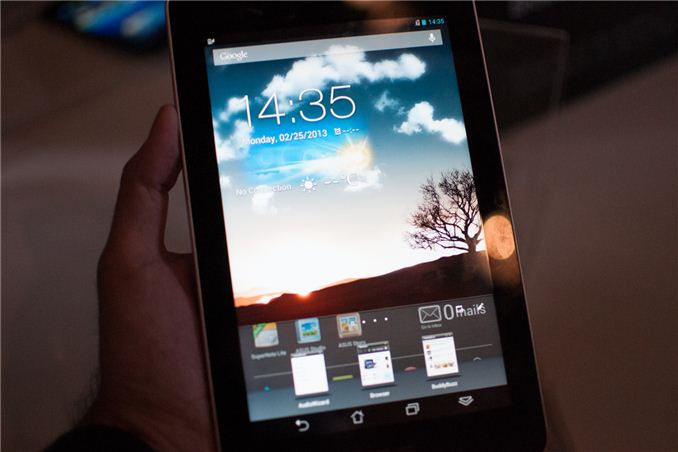
In its annual tradition at MWC, ASUS held a press conference off-site to introduce some of its mobile devices. The introductions are always interesting and typically unique in the marketplace. This year was no different.
To kick things off, ASUS introduced the Fonepad: a 7-inch Android 4.1.2 tablet that also serves as a phone. Samsung launched the Galaxy Note 8.0 earlier this week with a similar capability. While I don't expect many folks to want to hold a 7-inch tablet up to their face, having the ability to combine both tablet and smartphone functionality into one can be tempting. I can see the Fonepad being compelling if you don't make calls all that often but would rather carry a small tablet than a large smartphone, or if you are fine using a Bluetooth headset.
The device is pretty much a Nexus 7 but with a nice metal back. The dimensions are near identical to the Nexus 7 at 196.4mm x 120.1mm x 10.4mm with a weight of 340 grams. The display resolution remains 1280 x 800 and the IPS panel is LED backlit.
In a curious change of pace, ASUS integrated Intel's Atom Z2420 SoC (single-core + HT, 1.2GHz 32nm, PowerVR SGX 540). I'm curious to see how the single core, low-clocked Atom SoC does compared to Tegra 3 in a tablet. Driving all phone functionality is Intel's XMM 6265 baseband, with support for 850/900/1900/2100MHz WCDMA and 850/900/1800/1900MHz EDGE/GSM bands. There's support for 802.11b/g/n and BT 3.0.
The Fonepad features 1GB of LPDDR2 memory and 16GB of NAND on-board, with a microSD slot for additional storage expansion (a notable absence from the Nexus 7). There's an integrated 16Wh battery (like in the N7) and the device will be available in titanium gray and champagne gold (like the Transformer Prime).
The big selling point of the Fonepad is its price: $249. That's a pretty impressive deal for a full featured smartphone and 7-inch tablet in one. It's a bit of a quirky product, but I can definitely see the Fonepad filling a niche.
Next up is the ASUS PadFone Infinity. For those of you who aren't familiar with the PadFone concept, it's pretty simple. Take a phone that can dock into and power a tablet display and you have PadFone. The tablet part is strictly a display + battery, all compute and connectivity is driven by the phone element.
The PadFone Infinity takes a 5-inch 1080p Snapdragon 600 based smartphone running Android 4.2 and pairs it with a 10.1-inch 1920 x 1200 tablet dock (the PadFone Infinity Station). The phone weighs 141g and features an integrated 2400mAh battery, while the tablet dock weighs 530g and comes with a 5000mAh battery.
The phone integrates 2GB of LPDDR2-1066, and will come in both 32GB and 64GB versions. ASUS claims support for 802.11b/g/n and 802.11ac with WiFi Direct, BT 4.0 and NFC. Thanks to Qualcomm's baseband, there's full DC-HSPA+ and UE category 3 LTE support.
The PadFone features a 13MP rear facing camera with f/2.0 aperture lens and a 2MP front facing camera. When in tablet mode, the rear camera remains unimpeded while the front camera is replaced with a 1MP module.
Video out is supported via a Mobility DisplayPort interface (MyDP) that runs over the standard micro-USB port on the PadFone.


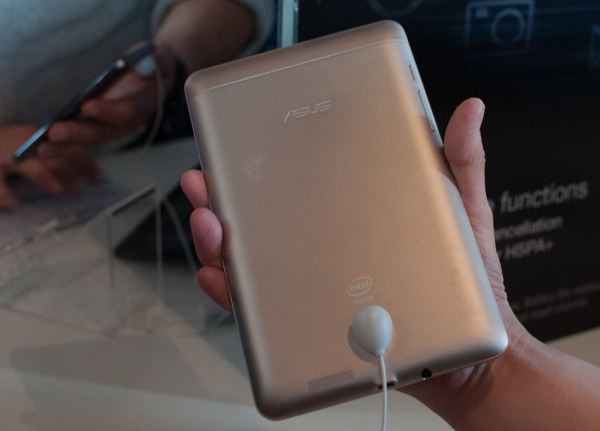

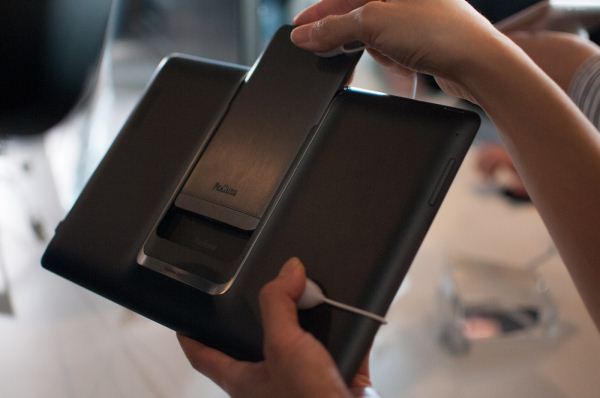
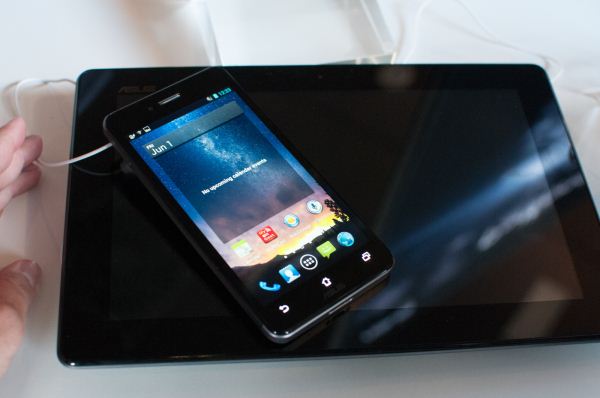
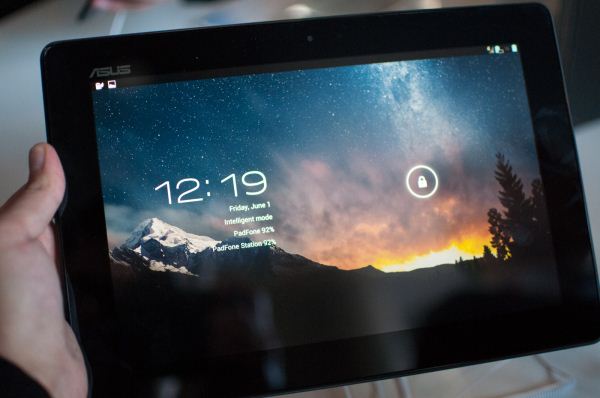














69 Comments
View All Comments
Wilco1 - Friday, March 1, 2013 - link
Selective benchmarking is exactly my issue with Anand's reviews, he doesn't show any CPU benchmarks, and in the JavaScript benchmarks he doesn't show the best scores.You'd be completely wrong if you believe that a Z2420 beats S3 on Vellamo. Anand's benchmark pages show the S3 scoring 2086 which is much higher.
So in which benchmarks does the Z2420 beat any A9? Vellamo is certainly not one of them. And claiming it beats a quad core is totally ridiculous. Hint: most of the benchmarks are single threaded.
It's funny how you talk about selective benchmarking and then make claims like that.
wsw1982 - Monday, March 4, 2013 - link
Read the link again, the website who tested Z2420 did show the Z2420 faster than S3 Exynos 4 on Vellamo, and Tegra 3 in some other benchmarks. And they should be more professional than both of us.Anyway, the comparison between the Z2420 and quad core ARMy (include the declaration that Z2420 faster than Exynos 4 quad) is only to make the selective comparison look funny, absurd and vivid. you did find it funny too, didn't you?
My point is the Z2420 beat dual core A9 on almost any benchmark (single or multi-thread) except the benchmark (Geekbench) you select. And they are the chip for same market segment (quad core arm should be comparing to Z2480/Z2580).
Wilco1 - Monday, March 4, 2013 - link
Why don't you read that webpage you linked again and point out where exactly does it compare Galaxy S3 with the X500? It doesn't even appear at all, so it must be in your imagination. And no, I don't rate fonearena very professional at all, certainly not compared with Anand.Yes, comparing a Z2420 with a modern ARM core is funny as it is so slow indeed. I guess that is exactly why fonearena avoided comparing it with Galaxy S3 and similar high-end phones.
Geekbench shows the same results as other benchmarks. A Galaxy S3 beats a Z2420 on any of the benchmarks in your link. Just search for the S3 scores and you'll see for yourself. I already posted the S3 Vellamo score.
Kidster3001 - Thursday, March 14, 2013 - link
There are very few real "CPU benchmarks" for Android. Most of them are Dalvik benchmarks. If the benchmark is not compiled for native execution using the NDK then it is only testing the efficiency of the Dalvik VM, not the CPU, this is a huge difference. Not very many do, a couple benchmarks I know of that use native code are AnTuTu and AndEBench.Kidster3001 - Thursday, March 14, 2013 - link
Vellamo HTML5 tests are just testing the browser and javascript engines. The v8 engine in the Razr i is very good.p.s. The metal tests in Vellamo are poorly compiled. They must be using generic flags.
RU482 - Tuesday, February 26, 2013 - link
I'd buy one in a heartbeat if it was a Windows 8 (or blue for that matter) phone instead of android.In fact, i'd really dig it if the phone was a 3.7" screen like my Samsung Focus Flash, with the ability to dock to say an 8.9-9.7" screen dock/tablet.
uhuznaa - Wednesday, February 27, 2013 - link
At $249 for a 3G-enabled 7" tablet with a 1280x800 IPS screen and a SD slot this thing will sell well enough. The fact that you also can use it as a phone if you want is just something like a free option thrown in.What I'm missing here is a solid well-integrated kickstand (like the MS Surface has), loud and clear front-facing speakers, and an array of good noise-cancelling mics. In fact I'm wondering how Asus could miss this. The bezels are huge enough to offer room for good speakers and a kickstand in the back cover isn't magic anyway. If you could easily use this thing as a hands-free phone propped up at a desk this would go a long way to avoid the "you look like a moron with a tablet pressed to your face" comments.
People use Skype and similar apps/services quite a lot on tablets and laptops and nobody offers comments about how silly it looks to press a laptop to your head. Ironically one of the weakest points of the Nexus 7 in this regard is its extremely poor speaker on the bottom and I guess the Fonepad won't be any better.
I would really like someone to come up with such a pad that actually has some thought and development applied to it and not just features thrown in. A pen-like BT headset that you can slot into the device for charging and that has a clip for wearing it in a shirt pocket or so would also go a long way to make such a pad actually usable as a phone.
RoninX - Saturday, March 2, 2013 - link
I agree that a pen-like BT headset would be the way to go. I vaguely remember that someone already developed an accessory like this, and it might have been ASUS...babis - Thursday, August 15, 2013 - link
I am very happy with my last purchase and mean the fonepad. Is terrific device and all the applications that I was using are working without problems.I think that Intel atom runs smoother that arm chips. Maybe is the hyper threading that makes it. In general I have that feeling.
The only problem that I encountered is with the Skype. It is working for making video chat and all other operations but It blocks the phone dialer after Skype installation.
its a fantastic machine and the only problem is with Skype that blocks the dialer
When I am dialing to the dialer the number that I want to call and hit the "green phone" button to call the number a pop up comes on and I can choose my cellular line and I can make the call.
have a look to that image (before installing skype):
http://imageshack.us/photo/my-images/716/5kgx.png/
After installing skype that option disappears and I can not make a cellular call.
It pop up a window to choose skype or android voip service.
have a look to that image (after installing skype):
http://imageshack.us/photo/my-images/812/b9hm.png/
That renders the capability to call thought my mobile number useless.
Before installing skype everything works as it should be. It reacts as is a tablet and not a mobile phone with a real sim card. And I think this is the problem. Installs the tablet version and not the phone version.
I am waiting from a reply ROM Skype but they always are so late at their reply.